| ||||||||||||||||||
| ||||||||||||||||||
| Venus: For planet-watching, Venus is pretty boring. It is covered with thick clouds and so details of the surface are never visible. It is the brightest planet in the night sky, and is therefore responsible for a large fraction of the 'UFO' sightings! Did you know that it is so bright that it can be seen in the daytime? |

|
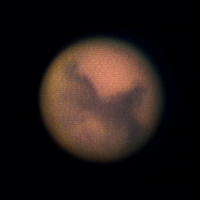
| Mars made another close approach in October 2005. This 30 frame movie was taken on October 29th over 2.5 hours. The bright tan patch at upper left is a major dust storm. At lower left a miniscule white dot is all that's left of the polar ice cap. NASA's Mars Exploration Rover 'Opportunity' is located roughly at the end of the large dark finger that points into the dust storm. Each frame is a stack of 50 of the best images out of a run of 500, with runs of 500 taken every 5 minutes with a ToUCam Pro II and 8" F10 LX200 with 2x barlow, processed in Registax. The contrast has been greatly stretched to help show surface features. |
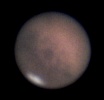
| This is a picture of Mars, taken on August 24th, 2003, when it was just days away from closest approach. Due to some thunderstorms in the area the seeing (atmospheric turbulence) was pretty awful, I hope to post a better picture soon. The white blob at lower left is the polar ice cap, and various landforms are visible. This is a stack of the 20 best video frames in 5 seconds of video. |
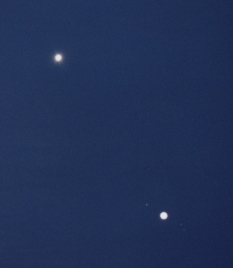
| Usually planets are far apart in the sky, but on rare occasions they appear to pass close to each other (in reality they're millions of miles apart). Early in 1999 Venus passed near Jupiter. Three of Jupiter's moons are visible. The background is bluish because this picture was taken before twilight ended. |
| The largest of our planets is Jupiter. This is pretty close to how it looks through a good telescope, although I have enhanced the colors a teensy bit so that it is easier to see detail in the belts. The Great Red Spot is not visible in this image. |
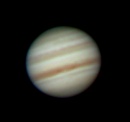
|

| Jupiter (movie) - A much smoother version in AVI format is here (225kb). You should be able to see the planet turn through about a quarter of a rotation. This took two and a half hours. The small satellite spitting out to the left of the planet is Io. In the very last frame of the movie you may be able to see Europa as it is just coming out from behind the planet (look a little below where Io came out for a small dot right on the edge of the planet). The Great Red Spot is not visible in this movie - it was on the other side of the planet when I took this. The little black things you see jumping around are specks of dust on the camera. |
| Uranus: This planet is very far away so we cannot see any details on the planet. It is a strange planet in that it has been tipped on its side; for many years at a time only one hemisphere will receive light. I have pointed out three of its moons so that you have something to look at. The bright bar coming out of the bottom of the planet is an artifact of the camera. See my FAQ if you want the details. |
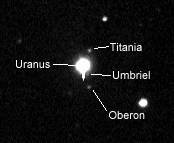
|
| That little dot inside the red circle is Pluto, the smallest and farthest of the nine major planets in our solar system. Interestingly, Pluto's orbit is much more elliptical than the other major planets, so when this image was taken the planet was actually closer to the Sun than Neptune (making it the eighth planet from the Sun). It has this position for about 20 years out of the 250 or so that it takes the planet to make an orbit. This is a mosaic of four 60 second exposures. |
| On July 29th, 2005, astronomers announced the discovery of three very large and very distant objects in the Kuiper Belt. One of them, 2003 UB313, is larger than Pluto! Some astronomers argue that it should thus be classified as the tenth planet in our solar system, while others (including me) disagree. I took this image of 2003 UB313 the night it was announced. I also took images of the other objects, 2005 FY9 and 2003 EL61. 2003 UB313 is so distant that it will be several days before its' motion against the sky is apparent. I intend to post an animation when I've collected enough frames. |
|
Why don't you head on to my Moon page now?
Or, you can go back to my main astronomy page for lots more good images!
Comments? Questions? Click here to send email to me, Fred Bruenjes.
All text and images are © 1995-2002 Manfred Bruenjes - All Rights Reserved. Image inlining is strictly prohibited. Email for permission before using an image or text.